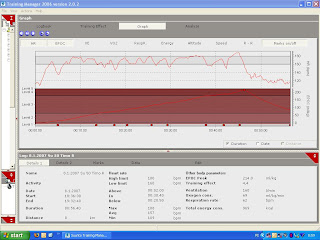The problems I’ve been having with my prevailing approach to diving appear to be even more fundamental than I had assumed after the DYN disaster.
The static competition regained some of my lost self confidence, as I managed to improve my competition record from 5:33 to 6:04 with a dive that felt like a 3min static. I quit my dive static right after 6min mark because I hadn’t done any over 4min statics in 3 years, and I was not sure of my static routines. I had told my coach/safety diver Timo that he would drag me up after 6min mark whether or not I wanted to come up voluntarily. After that I felt that I could have done 7min easily. And looking at the low qualification limits for static’s A- and B- finals, and the less than impressive results in both those finals I felt slightly disappointed that I hadn’t trained static more for these competitions.
So, I started to prepare myself for the DNF qualification heats. The main points I focused on were basically the points that I assumed were accountable for the DYN disaster:
- Over-doing the concentration: This time I took the approach that this is just one dive among many similar dives
- Range-philosophy: I dove 1 hand stroke at a time trying to listen to my body’s signals on remaining time
- Hyperventilation: No extraordinary breathing before 30sec to OT (this gave me time to ventilate the lungs 3-4 times before packing
- Dehydration: This time I drank the water constantly
- Acceleration: I constantly counted the hand strokes and was prepared to bail out if my pace got over 4 strokes per 25m.
Even though I succeeded in correcting all these mistakes I made in DYN I still managed to go beyond my capabilities, and the dive ended at BO at around 130m mark. The most puzzling thing was, that I felt good and in control the entire dive, and everything went as planned. Thinking with hindsight I had some O2-warnings going on at 125m mark, but in the empty-lung warm-ups I had managed to tolerate exactly the same kind of warnings for over 30sec with no problems at surfacing. And still I managed to BO. Apparently empty-lung statics are much more different than dynamic performances than I had expected.
Now I need to take some break from diving for a couple of weeks or so to gain some perspective into what the hell is going on with my diving. After that I need to discuss with other divers who have encountered similar problems to learn how they managed to deal with this kind of situation. Anyway, here are some preliminary ideas that I’ll be changing in my diving, in addition to all the other ones learned from the DYN disaster:
Paradigm change #1: No warm-ups
Out of the all DYN A-finalists only a few did anything that could be classified as warm-ups. Alexey did one 100m DYN with 1st attempt and exited the pool for around 30min and didn’t re-enter the pool until less than 2min to OT. Stig did a couple of 80m DYNs, and remained in the pool to breathe for 5-10min before OT. Basically all the other divers in both men’s and women's A-finals only went into the pool at around 1:30 before OT.
Comparing this to my warm-up routine of doing 1-2 full-lung statics, 2-4 50% dynamics and 3-5 empty-lung dives brings up a hugely differing pattern. I’m basically doing a semi-hard exercise before the actual max-attempt!
Paradigm change #2: Stay warm before the dive
I have intentionally sought to cool my body down before the dive, even if it means letting some water into the wetsuit. The rationale behind this is to strengthen the vasoconstriction and increase dive reflex, but it is possible that these advantages are more than offset by the facts that cool body requires more energy (oxygen) to stay warm and that O2 is more strongly bounded to cooler blood than warmer blood (which leads to BOs at higher pO2-levels). This should be easy to arrange as I plan to drop the warm-ups that usually causes the hypothermia.
Paradigm change #3: Quit instantly at O2-warnings
The ability to cope with O2-warnings in STA has nothing to do with the ability to tolerate them during DYN and DNF. When I notice O2-warnings in the future, I’ll abort the dive instantly. No matter how close some ‘milestone’ might be. No ‘milestone’ is worth risking yet another BO.
Paradigm change #4: Announce 1m
I found myself setting some milestones based on the speculations of A- and B-final limits. In the future I want my dives to be based on my own abilities instead of external requirements. One way to promote this approach is to announce so little, that you have no information on other diver’s performances.
Paradigm change #5: Less gear
In DYN finals no-one used pool suits. Most likely because they didn’t need them to cope with hypothermia because they did no warm-ups. In DNF I saw only Stig using a pool suit. All others dove in swimsuits or some extremely light suits made for competitive swimmers. Additionally some top divers, such as Natalia and Alexey dove without goggles, wearing only a small nose clip.
So, from now on I’ll be trying to dive max dives without pool suit and without goggles, and possibly even without a nose clip. If I find that some of these pieces of equipment are critically
required I’ll re-add them to my equipment category. Otherwise less is more.
But, anyway now off to a break from pool diving. I am pretty sure that I won’t be quitting pool diving, even at competitive level, but I have a lot of mind work to do regarding some fundamental questions related to it before I can go on with it.
Over and out.



